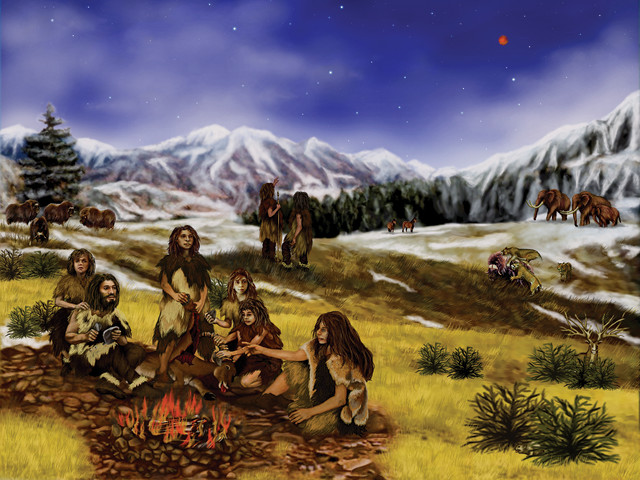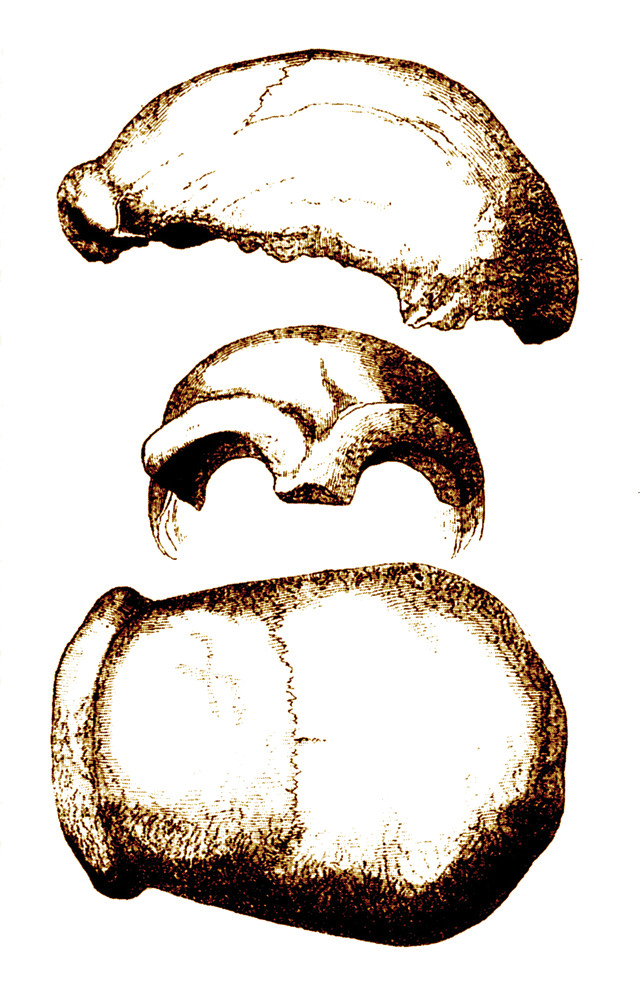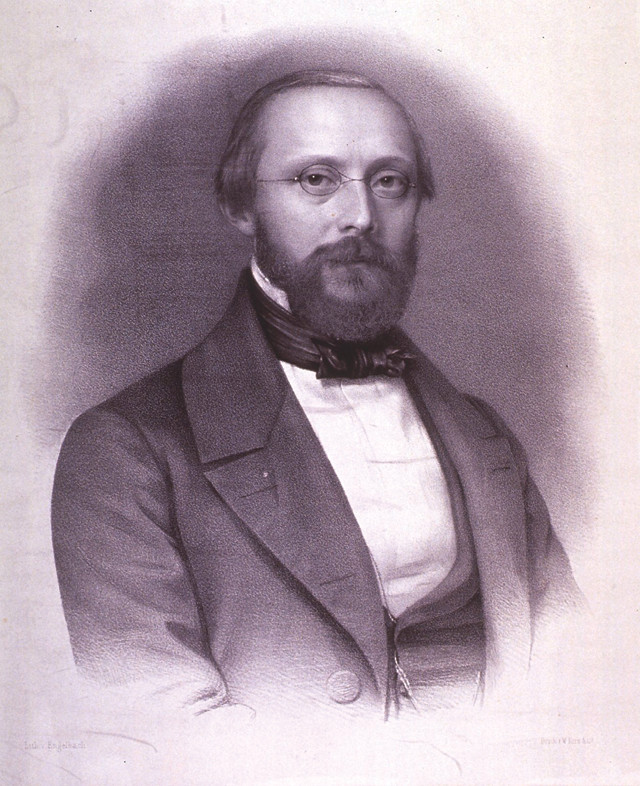
by Erin Wayman Tuesday, October 27, 2015

Artist's rendering of Neanderthals. Credit: art by Randii Oliver.
On July 11, 1997, six scientists announced they had sequenced DNA from a Neanderthal fossil. It was the first time anyone had analyzed the genetics of an extinct hominin, and the findings gave paleoanthropologists a new perspective on Neanderthals’ place in the human family tree.
The team, led by Svante Pääbo, then at the University of Munich in Germany, recovered the DNA from an upper arm bone. The bone was part of a collection of fossils discovered in 1856. Quarrymen working in the Feldhofer Cave in Germany’s Neander Valley found 16 bone fragments — including a skullcap, ribs, arms, legs and part of a hip — from several different individuals. The bones resembled human bones, but there were some striking differences: The skull had pronounced brow ridges and a low, sloping forehead, and the limb bones were extraordinarily thick.
The quarrymen thought the bones belonged to a bear and passed them onto a local schoolteacher, Johann Carl Fuhlrott. Fuhlrott believed the bones were human — perhaps an ancient race of Europeans that lived during the last ice age, he thought. He brought the bones to Hermann Schaaffhausen, an anatomist at the University of Bonn, who agreed that the bones represented an ancient group of people.
In 1864, William King, a geology professor at Queen’s College Galway in Ireland, noted that the cave deposits from which the bones came were at least 30,000 years old. That great age meant the bones were not only of an ancient group of people, King thought, but of an extinct group belonging to an entirely different species that he named Homo neanderthalensis, more commonly known as the Neanderthals (or sometimes spelled Neandertals — “tal,” once spelled “thal,” means “valley” in German).

The skullcap found in Feldhofer Cave in 1856 had prominent brow ridges and a low, sloping forehead — typical Neanderthal features. Credit: Wikimedia Commons.
The idea that Neanderthals were an extinct species was not unanimously accepted. Germany’s preeminent pathologist at the time, Rudolf Virchow, dismissed the discovery. He concluded that the bones represented a diseased individual of no great antiquity.
Many scientists accepted Virchow’s opinion initially. But when fossil hunters continued to find bones with the same physical peculiarities all over Europe, the idea that they belonged to an extinct species gained sway. With these initial finds, the classic image of Neanderthals as dim-witted cavemen took hold. Paleoanthropologists of the late 19th and early 20th centuries maintained that these ice age humans were extremely primitive. “A more ferocious looking, gorilla-like human being can hardly be imagined,” an 1873 article in Harper’s Weekly declared.
That view changed as new discoveries indicated Neanderthals were in many ways similar to modern humans. In 1908, French paleontologist Pierre Marcellin Boule discovered an almost complete Neanderthal skeleton in a cave near La Chapelle-aux-Saints, France. The individual had lost nearly all of its teeth and suffered from gum disease, and a reanalysis of the skeleton in the 1950s indicated that the “Old Man of La Chapelle,” as the individual is known, had osteoarthritis. Taken together, the evidence suggests Neanderthals cared for the sick and elderly, just as modern humans do. They also buried their dead in graves, manufactured sophisticated tools and perhaps even created art (although this is debated).
By the mid- to late 20th century, some paleoanthropologists questioned whether the differences between modern humans and Neanderthals were largely cosmetic. Researchers wondered whether Neanderthals might be the direct ancestors of Europeans. Others speculated that modern humans and Neanderthals might have interbred, with some people even carrying around Neanderthal genes today.

German pathologist Rudolf Virchow believed the bones found at the Feldhofer Cave in the Neander Valley belonged to a diseased individual, not an extinct species. Credit: National Library of Medicine.
These were hard questions to address using the physical features of skeletons and artifacts as evidence. Testing Neanderthal DNA would be a good way to tackle these questions, but that seemed impossible. DNA degrades quickly over time, so scientists did not expect to find DNA preserved in such ancient fossils. But in the mid-1980s, experiments with a quagga (an extinct zebra-like horse), an Egyptian mummy, a frozen mammoth and a variety of museum specimens demonstrated that bits of DNA could survive for hundreds or thousands of years.
But the quality of that DNA was poor, and the quantity was minute — scientists often recovered only a small fragment of one copy of DNA. To conduct DNA sequencing, researchers needed more DNA. In 1983, chemist Kary Mullis, while working for the biotech company Cetus Corporation in Emeryville, Calif., developed a technique, called polymerase chain reaction, which could quickly clone DNA in a process that mimics natural DNA replication. The method, which can produce millions of copies of DNA within a few hours, earned Mullis a Nobel Prize in chemistry in 1993.
With this technique, Pääbo and his colleagues extracted, cloned and sequenced a section of mitochondrial DNA collected from one of the original fossils found in the Neander Valley. Mitochondrial DNA is different from nuclear DNA, the DNA housed in the cell nucleus that makes up our 23 pairs of chromosomes and codes for the majority of our genes. Mitochondrial DNA is a much shorter strand of DNA that exists in mitochondria, organelles that help supply the cell with energy. Because each cell has up to a thousand copies of mitochondrial DNA compared to just two copies of nuclear DNA, the likelihood was much greater that the team would find mitochondrial DNA.
Once the team sequenced the mitochondrial DNA, they compared it with the mitochondrial DNA sequences of nearly 1,000 living humans. The results were clear: The Neanderthal DNA was very different from modern human DNA, outside the realm of known variation in the human gene pool. For example, any two modern human DNA sequences differed by an average of eight genetic differences; the Neanderthal sequence and modern human sequences had an average of 27 differences, the researchers reported in the journal Cell in 1997.
The results ended speculation that Neanderthals were the ancestors of Europeans. If Neanderthals had given rise to Europeans, then Neanderthal DNA would be most similar to European DNA. But when the team compared the Neanderthal sequence to sequences of different racial groups, they found all races differed from Neanderthals by the same number of genetic differences.
The team also used the molecular clock — a technique that uses the number of genetic differences between two species to determine when in the past they diverged from each other — to estimate that the lineages leading to Neanderthals and modern humans separated sometime between 690,000 and 550,000 years ago.
Since 1997, scientists have analyzed the mitochondrial DNA of several other Neanderthals, including the complete mitochondrial genomes (the entire length of the DNA) of more than five Neanderthals. These studies all produced similar results, showing Neanderthals were very different from humans, making it unlikely that Neanderthals contributed any genes to the modern human gene pool.
But mitochondrial DNA is only a small fraction of the genetic story. In 2006, advancements in genetic sequencing allowed scientists to analyze Neanderthal nuclear DNA. This year, a team again led by Pääbo, now at the Max Planck Institute for Evolutionary Anthropology in Leipzig, Germany, announced they had completed a “first draft” of the Neanderthal nuclear genome: By piecing together fragments from several Neanderthals, the team sequenced about 60 percent of the genome. Unlike the mitochondrial DNA, Neanderthal nuclear DNA suggests humans and Neanderthals did interbreed.
Studying nuclear DNA allows researchers to go beyond questions of our genetic relationship with Neanderthals to investigate what Neanderthals looked like and even how they behaved. In 2007, scientists found a genetic mutation in Neanderthals that is similar to a mutation found in people with red hair and pale skin, suggesting some Neanderthals were also red-headed. That same year researchers announced that Neanderthals had the modern form of the FOXP2 gene, which is associated with speech and language, suggesting Neanderthals may have had some ability to speak. With the rapid advancement of the field of Neanderthal genetics, researchers will likely address many more questions regarding our close cousins, allowing us to understand Neanderthals in ways Fuhlrott, Schaaffhausen and King never imagined.
© 2008-2021. All rights reserved. Any copying, redistribution or retransmission of any of the contents of this service without the expressed written permission of the American Geosciences Institute is expressly prohibited. Click here for all copyright requests.